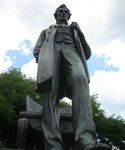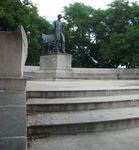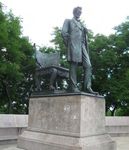Augustus St. Gaudens's Abraham Lincoln: The Man, 1887
←
→
Page content transcription
If your browser does not render page correctly, please read the page content below
Augustus St. Gaudens’s Abraham Lincoln: The Man, 1887 INTRODUCTION The statue known as the “Standing Lincoln,” located in the southern tip of Chicago’s Lincoln Park, is the most popular monument to Abraham Lincoln in the United States. The monument was financed by a bequest from Chicago lumber merchant Eli Bates (1806–1881) who left $40,000 in his will for an Abraham Lincoln monument in Lincoln Park. The committee formed to erect the monument staged a design competition to choose the artist, but in the end they rejected all of the original entries and selected Augustus St. Gaudens (1848–1907) instead. Born in Dublin, Ireland, St. Gaudens was raised in New York City, where he studied art at the Cooper Union and National Academy of Design before continuing his education at the École des Beaux Arts in Paris. When he returned to the United States, St. Gaudens became a leading figure in the “American Renaissance” art movement. The keen interest in Civil War memorials in the decades following the conflict helped boost St. Gaudens’s career. His first major commission was a statue of Civil War admiral David Farragut in New York, completed in 1881. Additional commissions followed rapidly. The commission for the “Standing Lincoln” held great meaning for St. Gaudens, as he was a tremendous admirer of the President. The sculptor had glimpsed Lincoln when he was traveling to Washington, DC, for his inauguration as the sixteenth President of the United States, and, after his assassination, had witnessed his body lying in state. © 2012 by the Chicago Metro History Education Center
Augustus St. Gaudens’s Abraham Lincoln: The Man, 1887
ACTIVITIES AND QUESTIONS
St. Gaudens began working on the monument in
1884. To capture Lincoln’s appearance, St.
Gaudens turned to two very different kinds of
models. For the face and hands, he relied on a
plaster life mask and casts of Lincoln’s hands
that another sculptor, Leonard Volk, had made
in 1860. Lincoln had visited Volk’s studio on Clark
Street in Chicago shortly before the Republican
convention of that year and Volk had made the
casts then. To arrive at the pose, St. Gaudens
relied on a live model. A friend of the sculptor
suggested that there were many “Lincoln-
shaped men” in Cornish, New Hampshire. St.
Gaudens traveled to Cornish and soon found the
perfect model in Langdon Morse, a 6’4” farmer
from nearby Windsor, Vermont. St. Gaudens
built a summer home and art studio in Cornish,
paving the way for the development of an
artists colony there.
From the time of its installation in 1887 to the
present day, the “Standing Lincoln” has met an
enthusiastic response from students, tourists,
academic historians, and art critics. In 1887, the
New York Evening Post described the work as
“the most important achievement American sculpture has yet produced.” In 1896 Chicago sculptor and
teacher Lorado Taft, who was also an influential art critic, neatly articulated the connection between the
achievements of the sculptor and those of his subject: “One
stands before it and feels himself in the very presence of
America’s greatest soul.”
Activities and Questions for Students
1. What other portraits of Lincoln have you seen, in any
medium (such as paintings, photographs, portrayals in
movies)? How does the portrayal of him in this sculpture
compare to the others?
2. Which image or images of Lincoln do you think are the
most powerful and why?
3. Viewers have praised the sculpture’s synthesis of the real
and the ideal. What aspects of the statue look the most
real to you? What aspects seem idealized?
© 2012 by the Chicago Metro History Education CenterAugustus St. Gaudens’s Abraham Lincoln: The Man, 1887
ACTIVITIES AND QUESTIONS
As he worked out the design for the statue,
St. Gaudens experimented with a variety of
poses: seated and standing, arms crossed in
front of his body, or holding a document.
The art critic Marianna Griswold Van
Rensselaer described the sculptor’s
solution to the problem in her review of the
monument in The Century (1887):
“The first question to be decided must
have been: Shall the impression to be given
base itself primarily upon the man of
action or upon the man of affairs? Shall the
statue be standing or seated? In the
solution of this question we find the most
striking originality of the work. The
impression given bases itself in equal
measure upon the man of action and the
man of affairs. Lincoln is standing, but
stands in front of a chair from which he has
just risen. He is before the people to
counsel and direct them, but has just
turned from that other phase of his
activity in which he was their executive
and their protector. Two ideas are thus
expressed in the composition, but they are
not separately, independently expressed
to the detriment of unity. The artist has
blended them to the eye as our own
thought blends them when we speak of
Lincoln. The pose reveals the man of
action, but represents a man ready for action, not really engaged in it; and the chair clearly typical of the Chair
of State reveals his title to act no less than his methods of self-preparation. We see, therefore, that
completeness of expression has been arrived at through a symbolic, idealistic conception.”
Activities and Questions for Students
1. What does this pose communicate to you?
2. Describe Lincoln’s clothing.
3. Why did the artist show Lincoln grasping his lapel?
4. Describe the chair behind him.
5. What symbols do you see on the chair? What do you think they mean?
6. What impression do the statue, chair, and symbols give you about Lincoln as a leader? How accurate
historically is this impression?
© 2012 by the Chicago Metro History Education CenterAugustus St. Gaudens’s Abraham Lincoln: The Man, 1887
ACTIVITIES AND QUESTIONS
The semi-circular plaza surrounding St. Gaudens’s
statue is called an exedra. It was designed by the
celebrated American architect Stanford White,
who had also collaborated with St. Gaudens on the
Farragut memorial in New York.
Activities and Questions for Students
1. Imagine the statue of Lincoln without the
monumental exedra. If the exedra were not
there, how would your impression of the
“Standing Lincoln” be altered?
2. How does the exedra function today as public
space?
3. The sculpture was designated a Chicago
Landmark in 2001. Why is it important for
works of public art to be designated as official
Chicago landmarks?
4. Who makes the decision about which works to
designate as landmarks? Whose opinions do
you think should count in such decisions?
© 2012 by the Chicago Metro History Education CenterAugustus St. Gaudens’s Abraham Lincoln: The Man, 1887
ACTIVITIES AND QUESTIONS
The inscriptions on the monument help situate Lincoln as a historical figure. The exedra behind the statue
features a series of short aphorisms. The pair of bronze globes on either side of the front steps are
inscribed with words from two famous documents penned by Lincoln: the Gettysburg Address (http://
www.ourdocuments.gov/doc.php?flash=true&doc=36) and the “Greeley letter,” (http://
teachingamericanhistory.org/library/index.asp?document=1057) in which the President made it clear that
his primary goal was to save the Union (rather than to end slavery). The choice of the Greeley letter rather
than the more famous Emancipation Proclamation (http://www.ourdocuments.gov/doc.php?doc=34)
makes the subject of the monument, in the words of critic Charles Henry Hart, “not Abraham Lincoln the
liberator of slaves, but Abraham Lincoln the Saviour of the Union.”
Activities and Questions for Students
1. What role do the quotations inscribed on the globes and on the exedra behind the statue play in the
overall composition?
2. If you were going to add further quotations, what documents would you choose?
3. Why are two of the quotations inscribed on spheres? Why do you think the sculptor chose that shape?
4. What interpretation do the statue, the exedra, and the globes offer about the meaning of the Civil War?
What does this interpretation imply about the meaning of American democracy? Do you agree with
these interpretations?
© 2012 by the Chicago Metro History Education CenterAugustus St. Gaudens’s Abraham Lincoln: The Man, 1887 ADDITIONAL RESOURCES AND BIBLIOGRAPHY Julia Sniderman Bachrach, City in a Garden: A Photographic History of Chicago’s Parks (Placitas, N.M.: Center for American Places, in association with the Chicago Park District, 2001), 3-35, 104-111. Chicago Park District web page on “Fountains, Monuments and Sculptures” in Chicago: (http:// www.cpdit01.com/resources/planning-and-development.fountains-monuments-and-sculptures/). Marianna Griswold Van Rensselaer, “Saint Gaudens’s Lincoln,” The Century 35 (November 1887), 37–39. James L. Riedy, Chicago Sculpture (Urbana: University of Illinois Press, 1981), 175–248. Kirk Savage, Standing Soldiers, Kneeling Slaves: Race, War, and Monument in Nineteenth-Century America (Princeton: Princeton University Press, 1997), 89–128. Lorado Taft, “American Sculpture and Sculptors,” Chautauquan 22 (January 1896): 387–95. © 2012 by the Chicago Metro History Education Center
You can also read


























































